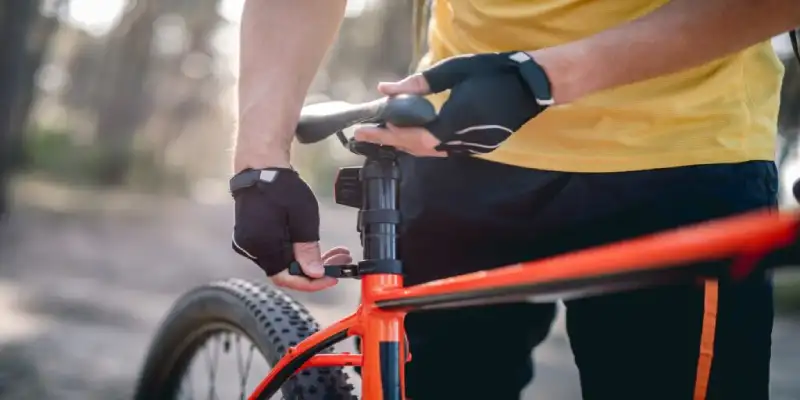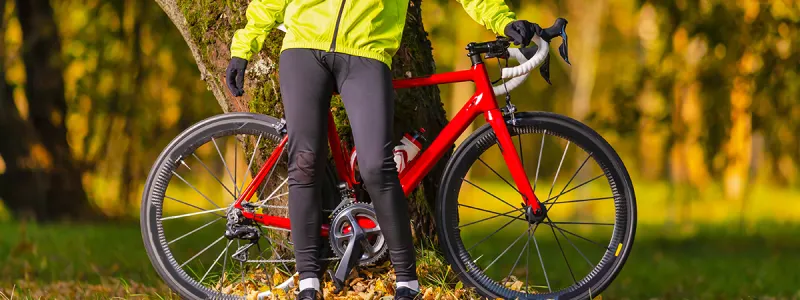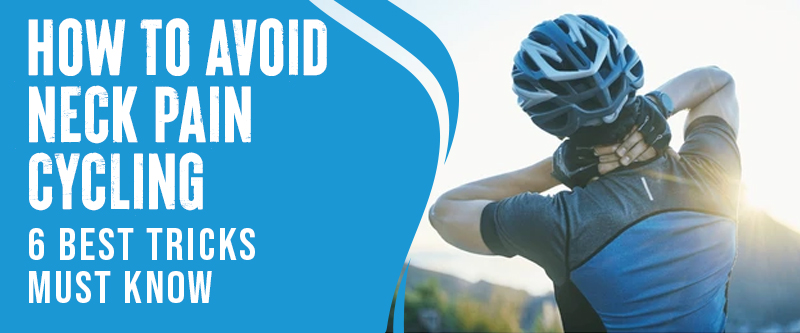Neck pain while cycling is commonly caused by excessive weight on the upper limbs, resulting in increased pressure on the neck. The discomfort may arise from incorrect bike fit, improper posture, or suboptimal riding technique. It’s crucial not to disregard neck pain, as it can escalate into chronic issues.
Your chin should be tucked in, your neck long, and your shoulder blades should be down (depressed) and back (retracted).
This guide will discuss practical and actionable tips to avoid neck pain while cycling and, most importantly, enjoy your ride.
How to Avoid Neck Pain Cycling: 6 Best Tricks

Neck pain can lead to more severe injuries and even force cyclists to take a break from their beloved sport. You can take numerous steps to avoid neck pain. Our discussion will focus on how to avoid neck pain.
Proper Bike Fit
A proper bike fit is the foundation of comfortable and efficient cycling. An incorrectly set up bike can cause discomfort, pain, and injuries. A good bike fit reduces the risk of injury and improves the rider’s performance. Here are some reasons why proper bike fit is essential:
- It ensures comfort and reduces discomfort while riding.
- It helps maintain an efficient and effective riding position that uses energy and power more efficiently.
- It reduces the risk of injury to joints, muscles, and ligaments.
- It optimizes the rider’s aerodynamic position, resulting in faster and smoother riding.
Adjusting the Seat Height
It’s one of the crucial factors in bike fit. An incorrect seat height can cause knee, back, and neck pain. Therefore, it is essential to adjust the seat height based on the rider’s height, inseam, and riding style. Here are some tips to adjust the seating height:
- Adjust the saddle height so the saddle is at hip height.
- Pedal the bike while sitting on it.
- When the pedal is at the lowest position, there should be a slight bend in the knee.
- If the leg is straight, the seat height is too high, and if the knee is too bent, the seat height is too low.
- Adjust the seat height until you find the ideal position to pedal comfortably without overstraining the legs or the back.
Adjusting Handlebar Height
The Handlebar height is crucial for bike fit and seat height to avoid neck pain. Too low, and the rider hunches, leading to back and neck pain. Too high, the rider sits too upright, causing discomfort in hands, wrists, and arms. Adjust handlebar height based on flexibility, riding posture, and comfort. Here are some tips for adjusting it:
- Install a stem that fits the bike frame and the handlebars.
- Ensure that the stem is tightened securely and is compatible with the handlebar clamp diameter.
- Use spacers to adjust the handlebar height.
- Experiment with different heights until you can comfortably reach the handlebars without overstraining the neck or the back.
Correct Cycling Posture

Proper cycling posture is crucial for avoiding neck pain and other injuries. It enables the rider to maintain a stable and balanced position on the bike, optimizing energy efficiency and reducing unnecessary strain on the joints and muscles. A good cycling posture includes the following:
- A neutral spine.
- Relaxed shoulders.
- Slightly bent arms and elbows.
- Engaged core muscles.
Maintaining a Neutral Spine
Maintaining a neutral spine is crucial to avoid neck pain. A neutral spine means that the spine’s natural curves are maintained while cycling, avoiding excessive rounding of the upper back and neck. Here are some tips to keep a neutral spine:
- Sit on the bike with a straight back and relaxed shoulders.
- Bend your elbows and keep your core muscles engaged.
- Avoid rounding the upper back or hunching over the handlebars.
- Heighten the seat and handlebars to ensure that the spine is comfortable and for easy reach to the handlebars.
Lowering Shoulders and Relaxing Arms
Lowering shoulders and relaxing arms are essential to reducing upper body discomfort. A tense upper body can strain the neck, shoulders, and upper back muscles, leading to pain and discomfort. Here are some tips to lower shoulders and relax arms:
- Drop your shoulders down and away from the ears.
- Make sure your elbows are slightly bent and relaxed.
- Avoid gripping the handlebars too tightly.
- Keep your hands and wrists straight and relaxed.
Lowering Shoulders and Relaxing Arms
Incorporating neck exercises into your routine is a proactive approach to ward off potential pain and discomfort. Stretching and strengthening neck muscles contribute to a more enjoyable and pain-free cycling experience.
Stretching Exercises for Neck Muscles
Stretching exercises can help improve the neck muscle’s flexibility, reducing the risk of neck pain. Here are a few stretching exercises that you can do before and after cycling:
- Neck Roll: Gently roll your head circularly, bringing your ear to your shoulder and then rolling towards the back. Repeat this on both sides for 10-15 seconds.
- Shoulder Blade Squeeze: Sit up tall, pull together your shoulder blades, then release.
- Chin Tucks: Sit tall and slowly tuck your chin towards your chest. Hold for a few seconds, and then release.
Strengthening Exercises for Neck Muscles
Strengthening neck muscles can improve their endurance, helping you avoid neck pain. Here are a few strengthening exercises that you can do:
- Resistance Band: Hold one end of a resistance band or towel and place the other behind your head. Use your neck muscles to pull your head back, holding and releasing.
- Neck Extensions: Lie on your back with a rolled-up towel under your neck. Slowly lift your head off the floor, holding it for a few seconds and lowering it back down.
- Isometric Shoulder Shrugs: Sit tall and lift your shoulders towards your ears, holding and releasing for a few seconds.
Importance of Flexibility
Flexibility helps avoid neck pain while cycling. Tight neck muscles can lead to poor posture and increased strain on the neck. By incorporating neck stretching exercises into your pre and post-cycling routine, you can help to maintain proper posture and reduce the risk of neck pain.
Equipment

Selecting the right cycling equipment can significantly avoid neck pain and ensure a comfortable ride. Each choice, from helmets to handlebar padding, contributes to your overall biking experience.
Choosing the Fitting Helmet
Choosing a fitting helmet can avoid neck pain while cycling. Here are some things to consider when choosing a helmet:
- Proper Fit: Ensure your helmet fits snugly on your head and does not move around while cycling.
- Helmet Weight: A lighter helmet can help to reduce the strain on your neck muscles.
- Helmet Design: Consider a helmet with a streamlined design to reduce wind resistance.
Adding Handlebar Padding
Handlebar padding can help reduce vibration and shock, contributing to neck pain while cycling. Consider adding padding to your handlebars, especially if you frequently cycle on uneven terrain.
Using a Neck Brace
A neck brace can support the neck muscles to reduce neck pain. Consider using a neck brace if you have a history of neck pain or if you plan on cycling for an extended period.
Hydration
Staying hydrated is critical when cycling to avoid neck pain. Water deficiency causes muscle pain, including neck pain. For cycling hydration, follow these tips:
- Drink Water: Carry a water bottle and drink water regularly while cycling.
- Electrolyte Drinks: During extended cycling sessions, consider drinking electrolyte drinks to replenish lost fluids and minerals.
- Avoid Alcohol: Alcohol can lead to dehydration, so it’s essential to avoid alcohol before and during cycling.
Relation Between Hydration and Neck Pain
There is a significant relationship between hydration and neck pain. When dehydrated, your neck muscles can become tight and stiff, leading to pain and discomfort. By staying properly hydrated, you can help avoid neck pain.
Recommended Water Intake
The recommended water intake while cycling varies depending on age, weight, and intensity. A general guideline is to drink at least 8 ounces of water every 15-20 minutes while cycling. If you’re cycling for an extended period or in hot weather, consider drinking more water to stay hydrated.
Riding Technique: Smooth and Steady

Staying hydrated is a fundamental aspect of maintaining overall health and can play a crucial role in avoiding neck pain during cycling. Let’s explore the importance of hydration and its direct relationship to neck comfort.
Avoiding Sudden and Jerky Movements
One of the most important things you can do when riding a bike is to avoid sudden and jerky movements. This includes sudden accelerations or decelerations, sudden turns, and sudden stops. These types of movements can cause your neck muscles to strain and tighten, leading to pain and discomfort. Here are some tips for avoiding sudden and jerky movements:
- Use a smooth and steady pedaling technique.
- Anticipate changes in the road or trail in advance.
- Preparation is key to avoiding sudden turns or stops.
- Don’t slam on the brakes, slow down.
Smooth Pedaling Technique
Smooth and steady pedaling is one of the vital riding techniques that can help you avoid neck pain while cycling. This technique involves maintaining a consistent cadence (rpm), using a correct gear ratio, and avoiding sudden pedaling movements. Here are some tips for maintaining a smooth pedaling technique:
- Use a moderate gear ratio to pedal comfortably and maintain a consistent cadence.
- Focus on engaging your core muscles, keeping your upper body stable.
- Avoid bouncing or “over-spinning” your pedals.
- Experiment with different cadences to find the most comfortable and efficient.
Importance of Taking Breaks
Taking breaks is an essential part of avoiding neck pain while cycling. Riding for extended periods without breaks can tire and strain your neck muscles, leading to pain and discomfort. Here are some tips for taking breaks while cycling:
- Take a break every 30-60 minutes, depending on the intensity and duration of your ride.
- Use your breaks to stretch your neck, shoulders, and back.
- Use your breaks to refuel and rehydrate.
- Plan your route to include rest stops and amenities.
Conclusion
Cycling can be a delightful activity, but it’s essential to be mindful of its impact on your neck and overall health. While cycling, taking avoidive measures such as ensuring proper bike fit, maintaining correct posture, and engaging in neck exercises is crucial.
Select the right equipment, such as a suitable helmet, handlebar padding, or neck brace. Staying hydrated, taking breaks, and avoiding jerky movements during rides are also vital factors. By implementing these measures, you can fully embrace the exhilaration and fun of cycling while keeping your neck pain-free.
FAQs
Why Does Riding A Bike Hurt My Neck?
You won’t be able to eliminate all your stress, but you can reduce some of it by adjusting the handlebar height and position. Avoid hunching over as much as possible to avoid back and neck pain caused by excessive reach to the handlebars.


